Volvo S40-V40 2001 Owner's Manual
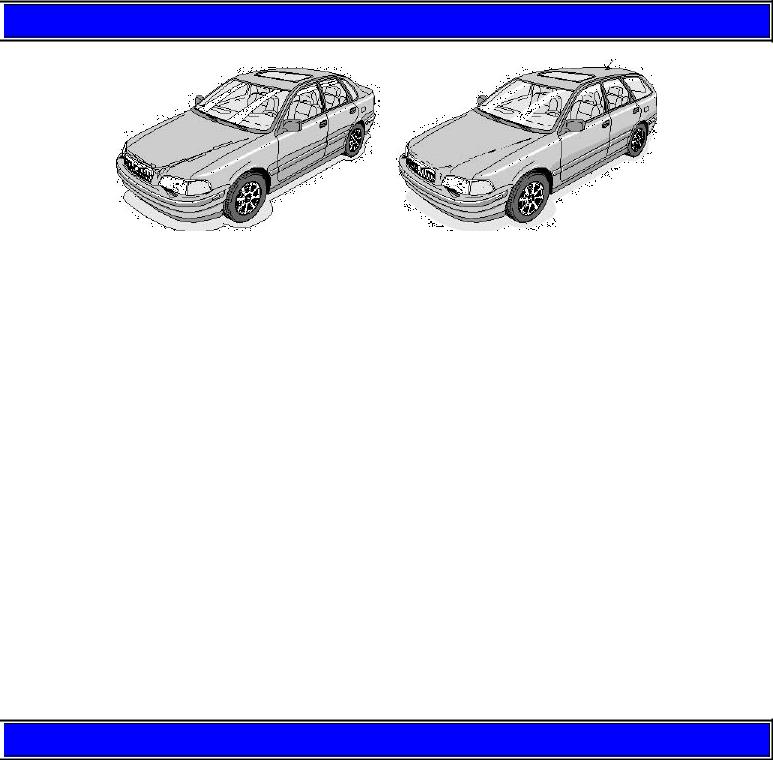
2 0 0 1 VOLVO S40 & V 40

 This manual deals with the operation and care of your Volvo.
This manual deals with the operation and care of your Volvo.
Welcome to the worldwide family of Volvo owners. We trust that you will enjoy many years of safe driving in your Volvo, an automobile designed with your safety and comfort in mind. To help ensure your satisfaction with this vehicle, we encourage you to familiarize yourself with the equipment descriptions, operating instructions and maintenance requirements/recommendations in this manual. We also urge you and your passengers to wear seat belts at all times in this (or any other) automobile. And, of course, please do not operate a vehicle if you may be affected by alcohol, medication or any impairment that could hinder your ability to drive.
Your Volvo is designed to meet all applicable safety and emission standards, as evidenced by the certification labels attached to the driver's door opening and on the left wheel housing in the engine compartment.
For further information please contact your retailer, or:
In the USA:
Volvo Cars of North America
Customer Relations
P.O. Box 914
Rockleigh, New Jersey 07647-0914 800-458-1552
We also invite you to visit our Home Page on the Internet at:
http://www.volvocars.com

 Contents
Contents
Contents

Chapter 1 - Occupant safety
Chapter 2 - Instruments, switches and controls
Chapter 3 - Body and interior
Chapter 4 - Starting and driving
Chapter 5 - Wheels and tires
Chapter 6 - In case of an emergency
Chapter 7 - Car care
Chapter 8 - Volvo Service
Chapter 9 - Specifications
Chapter 10 - Audio systems
Index

 General information
General information
Important
Before you operate your car for the first time please familiarize yourself with the engine oil consumption information and refueling recommendations on pages 58 and 59. You should also be familiar with the information in the first three chapters of this manual.
Information contained in the balance of the manual is extremely useful and should be read after operating the vehicle for the first time.
The manual is structured so that it can be used for reference. For this reason, it should be kept in the car for ready access.
Do not export your Volvo to another country before investigating that country's applicable safety and exhaust emission requirements. In some cases it may be difficult or impossible to comply with these requirements. Modifications to the emission control system(s) may render your Volvo not certifiable for legal operation in the U.S., Canada and other countries.
All information, illustrations and specifications contained in this manual are based on the latest product information available at the time of publication. Please note that some vehicles may be equipped differently, depending on special legal requirements and that optional equipment described in this manual may not be available in all markets.
Volvo reserves the right to make model changes at any time, or to change specifications or design, without notice and without incurring obligation.
Shiftlock

When your car is parked, the gear selector is locked in the (P)ark position. To release the selector from this position, turn the ignition key to position II (or start the engine), depress the brake pedal, press the button on the front of the gear selector knob and move the selector from (P)ark.
If it is necessary to manually override the shiftlock system:
·Turn the starting (ignition) key to position I
·Press firmly on the "SHIFTLOCK OVERRIDE" button located at the base of the gear selector
·While holding the override button down, press the button on the front of the gear selector
·Move the selector from the (P)ark position.
Keylock
When you switch off the ignition, the gear selector must be in the (P)ark position before the key can be removed.
Anti-lock Brake System (ABS)
The ABS system in your car performs a self-diagnostic test when the vehicle first reaches the speed of approximately 12 mph (20 km/h). The brake pedal will pulsate several times and a sound may be audible from the ABS control module. This is normal.
Fuel filler door
When you lock the doors, the fuel filler door also locks, with a delay of 10 minutes. When all doors are unlocked, the fuel filler door is also unlocked. Your key, keyless remote, and the door lock button in the driver's door control pod will all unlock the fuel filler door. To open the unlocked fuel filler door, press at the forward edge of the door. See pages 39 for information about locking and unlocking features.
© 1999 Volvo Cars of North America Inc.

 Volvo and the environment
Volvo and the environment
Volvo is committed to the well being of our customers. As a natural part of this commitment, we care about the environment in which we all live. Caring for the environment means an everyday involvement in reducing our environmental impact.
Volvo's environmental activities are based on a holistic view, which means we consider the overall environmental impact of a product throughout its complete life cycle. In this context, design, production, product use, and recycling are all important considerations.
In production, Volvo has partly or completely phased out several chemicals including freons, lead chromates, naphtanates, asbestos, mercury and cadmium; and reduced the amount of chemicals used in our plants 50% since 1991.
In use, Volvo was the first in the world to introduce into production a three-way catalytic converter with a Lambda sond, now called oxygen sensor, in 1976. The current version of this highly efficient system reduces emissions of harmful substances (CO, HC, NOx) from the exhaust pipe by approximately 95% and the search to eliminate the remaining emissions continues. Volvo is the only automobile manufacturer to offer CFC-free retrofit kits for the air

conditioning system for all models as far back as the M/Y 1975 240. Advanced electronic engine controls, refined purification systems and cleaner fuels are bringing us closer to our goal.
After Volvo cars and parts have fulfilled their use, recycling is the next critical step in completing the life cycle. The metal content is about 75% of the total weight of a car, which makes the car among the most recycled industrial products. In order to have efficient and well controlled recycling, many Volvo variants have printed dismantling manuals, indicating the weight and material of individual components. For Volvo, all homogeneous plastic parts weighing more than 1.7 oz. (50 grams) are marked with international symbols that indicate how the component is to be sorted for recycling.
In addition to continuous environmental refinement of conventional gasoline-powered internal combustion engines, Volvo is actively looking at advanced technology alternative-fuel vehicles.
When you drive a Volvo, you become our partner in the work to lessen the car's impact on the environment.
To reduce your vehicle's environmental impact, you can:
·Maintain proper air pressure in your tires. Tests have shown decreased fuel economy with improperly inflated tires
·Follow the recommended maintenance schedule
·Drive at a constant speed
·See an authorized Volvo retailer as soon as possible for inspection if the check engine (malfunction indicator) lamp illuminates, or stays on after the vehicle has started
·Properly dispose of any vehicle related waste such as used motor oil, used batteries, brake pads, etc.
·When cleaning your car, use Volvo's own car care products, all of which have systematically been adapted to the environment
For additional information regarding the environmental activities in
which Volvo Cars of North America, Inc. and Volvo Car Corporation are involved, visit our Internet Home Page at:
http://www.volvocars.com
Top of Page
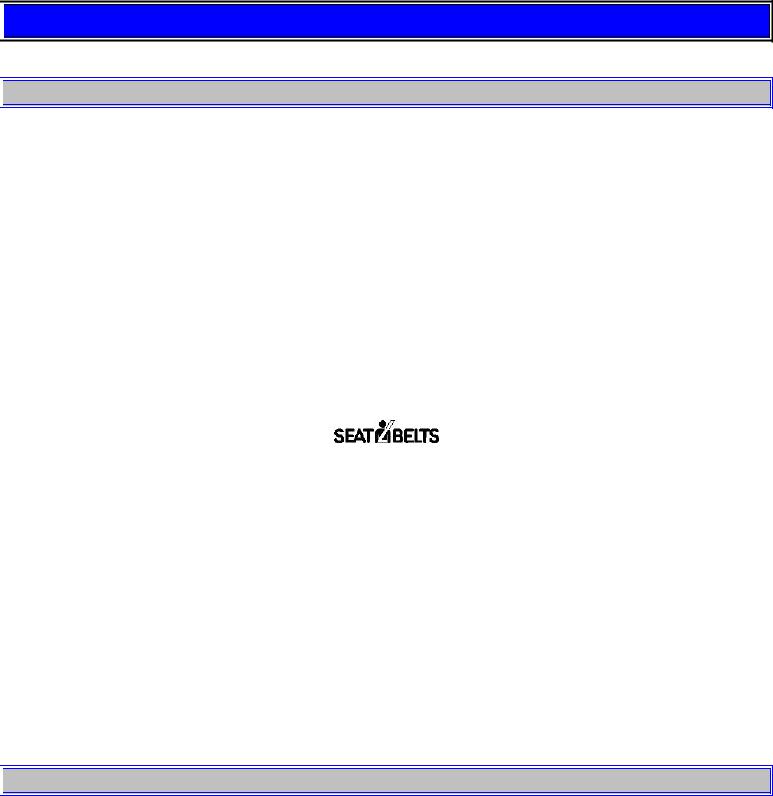
2 0 0 1 VOLVO S40 & V 40

 Chapter 1 - Occupant safety
Chapter 1 - Occupant safety

 pg. 1 Occupant safety
pg. 1 Occupant safety
Occupant safety
Not wearing a seat belt is like believing "It'll never happen to me!" Volvo, the inventor of the three-point seat belt, urges you and all adult occupants of your car to wear seat belts and ensure that children are properly restrained, using an infant, car or booster seat determined by age, weight and height. Volvo also believes no child should sit in the front seat of a car and that no one under 4 feet 7 inches should ride as a passenger in the front seat of any vehicle equipped with a passenger side airbag.
Fact: In every state and province, some type of child-restraint legislation has been passed. Additionally, most states and provinces have already made it mandatory for occupants of a car to use seat belts.
So, urging you to "buckle up" is not just our recommendation - legislation in your state or province may mandate seat belt usage. The few seconds it takes to buckle up may one day allow you to say, "It's a good thing I was wearing my seat belt".
Seat belts 2
Volvo SRS 4
Side Impact Protection System - (SIPS) air bag 8
WHIPS 9
IC system 10
Child safety, Booster cushion 11
Child restraint anchorages 14
Reporting Safety Defects 16

 pg. 2 Seat belts
pg. 2 Seat belts
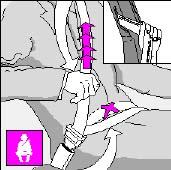
Seat belts
Always fasten the seat belts before you drive or ride.
Two lights above the rear view mirror will be illuminated for 4-8 seconds after the starting
(ignition) key is turned to the driving position. A chime will sound at the same time if the driver has not fastened his seat belt. The rear seats are provided with selfretracting inertial reel belts. The front seats are provided with single roller belts with tensioners.
To buckle:
Pull the belt out far enough to insert the latch plate into the buckle until a distinct snapping sound is heard. The seat belt retractor is normally "unlocked" and you can move freely, provided that the shoulder belt is not pulled out too far. The retractor will lock up as follows:
·if the belt is pulled out rapidly
·during braking and acceleration
·if the vehicle is leaning excessively
·when driving in turns
For the seat belt to provide maximum protection in the event of an accident, it must be worn correctly. When wearing the seat belt remember:
·The belt should not be twisted or turned.
·The lap belt must be positioned low on the hips (not pressing against the abdomen).
·The shoulder section of the front seat belts adjusts automatically to the driver's height.
Adjusting the shoulder belt
Lap portion of the seat belt should sit low
Make sure that the shoulder belt is rolled up into its retractor and that the shoulder and lap
belts are taut.
Before exiting the car, check that the seat belt retracts fully after being unbuckled.
If necessary, guide the belt back into the retractor slot.
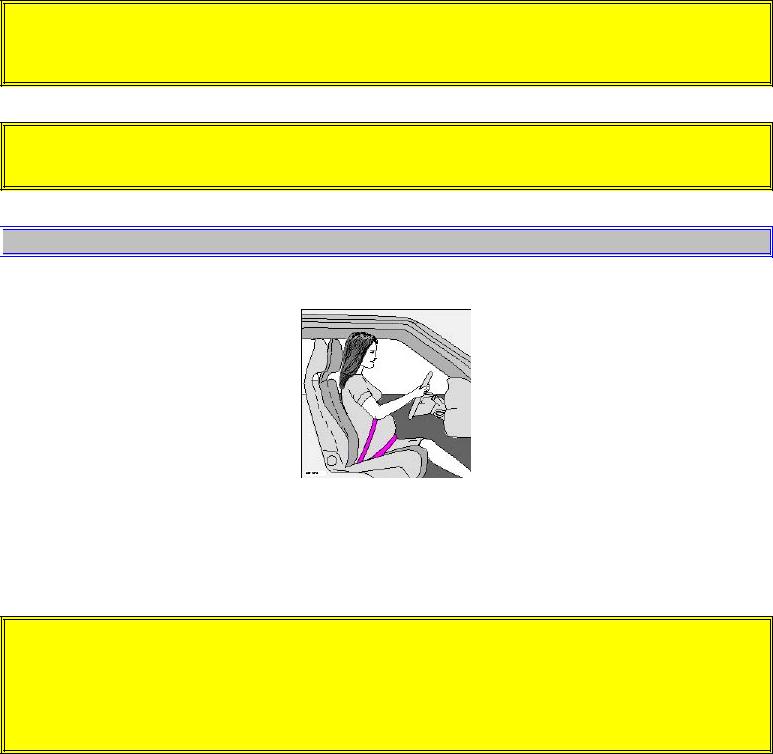
NOTE: Legislation in your state or province may mandate seat belt usage.
WARNING!
Any device used to induce slack into the shoulder belt portion of the three-point belt system will have a detrimental effect on the amount of protection available to you in the event of a collision. The seat back should not be tilted too far back. The shoulder belt must be taut in order to function properly.
WARNING!
Do not use child safety seats or child booster cushions/backrests in the front passenger's seat. We also recommend that children who have outgrown these devices sit in the rear seat with the seat belt properly fastened.

 pg. 3 Seat belts, Head restraints
pg. 3 Seat belts, Head restraints
During pregnancy
Pregnant women should always wear seat belts. Remember that the belt should always be positioned in such a way as to avoid any possible pressure on the abdomen. The lap portion of the belt should be located low, as shown in the above illustration.
WARNING!
Never use a seat belt for more than one occupant. Never wear the shoulder
portion of the belt under the arm, behind the back or otherwise out of position. Such use could cause injury in the event of an accident. As the seat belts lose much of their strength when exposed to violent stretching, they should be replaced after any collision, even if they appear to be undamaged. Never repair the belt on your own; have this work done by an authorized Volvo retailer only.
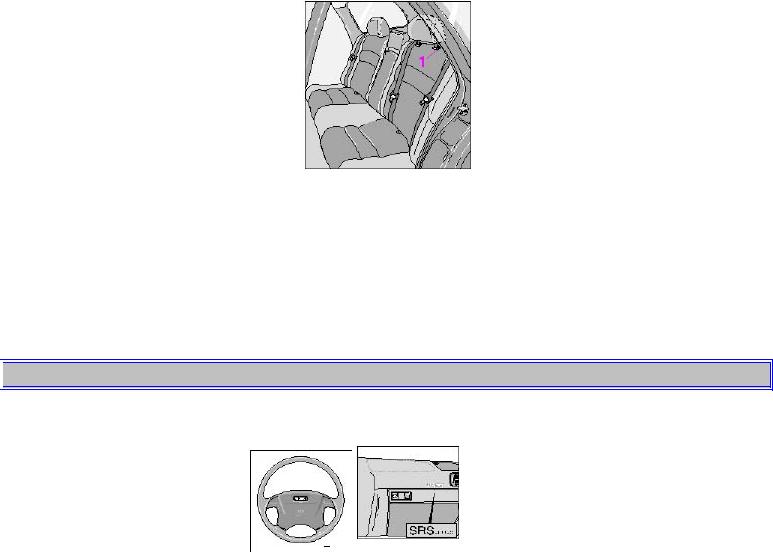
Rear head restraints
The rear head restraints can be adjusted according to the passenger's height. The restraint should be carefully adjusted to support the occupant's head.
The head restraint can be raised by pulling straight up or lowered by pressing the catch (1) at the base of the left head restraint support and pushing down.

 pg. 4 Volvo SRS
pg. 4 Volvo SRS
Passenger side SRS hatch
As an enhancement to the three-point seat belt system, your Volvo is equipped with a Supplemental Restraint System (SRS). The Volvo SRS consists of an airbag (2) on both the driver's and passenger's sides and seat belt tensioners in both front door pillars (4). The system is designed to supplement the protection provided by the three-point seat belt system.
The SRS system is indicated by the "SRS" embossed on the steering wheel pad and above the glove compartment, and by decals on both sun visors and on the far right side of the dash.
The airbags are folded and located in the steering wheel hub and above the glove compartment. They are designed to deploy during certain frontal or front-angular collisions, impacts, or decelerations, depending on the crash severity, angle, speed and object impacted. The airbags may also deploy in certain non-frontal collisions where rapid deceleration occurs.
The airbag system includes gas generators (1) surrounded by the airbags (2) and front seat belt tensioners for both of the front seats (4). To deploy the system, the sensor (3) activates the gas generators causing the airbags to be inflated with nitrogen gas. As the movement of the seats' occupants compresses the airbags, some of the gas is expelled at a controlled rate to provide better cushioning. Both seat belt tensioners also deploy, minimizing any seat belt slack.
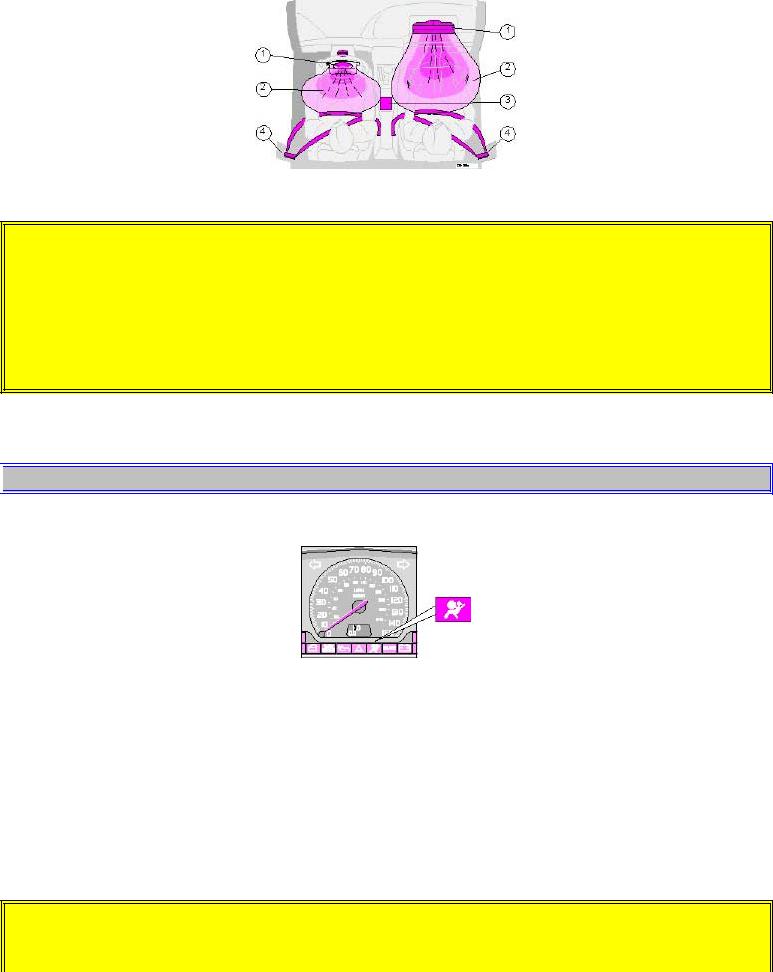
The entire process, including inflation and deflation of the airbags, takes approximately two-tenths of a second.
WARNING!
·As its name implies, SRS is designed to be a SUPPLEMENT to - not a replacement for - the three-point belt system. For maximum protection, wear seat belts at all times. Be aware that no system can prevent all possible injuries that may occur in an accident.
·When installing any optional equipment, make sure that the SRS system is not damaged. Do not attempt to service any component of the SRS yourself. Attempting to do so may result in serious personal injury. If a problem arises, take your car to the nearest authorized Volvo retailer for inspection as soon as possible.

 pg. 5 Volvo SRS
pg. 5 Volvo SRS
A self-diagnostic system incorporated into the sensor monitors the SRS, SIPS and IC-system. If a fault is detected, the "SRS" warning light will illuminate. The light is included in the warning/indicator light cluster in the instrument panel. Normally, the SRS warning lamp should light up when the ignition is switched on and should go out after 5 seconds or when the engine is started. Check that this light is functioning properly every time the car is started.
The following items are monitored by the self-diagnostic system:
·Sensor unit
·SRS wiring
·Inflators
WARNING!
Never drive an SRS equipped car with your hands on the steering wheel pad / airbag housing.
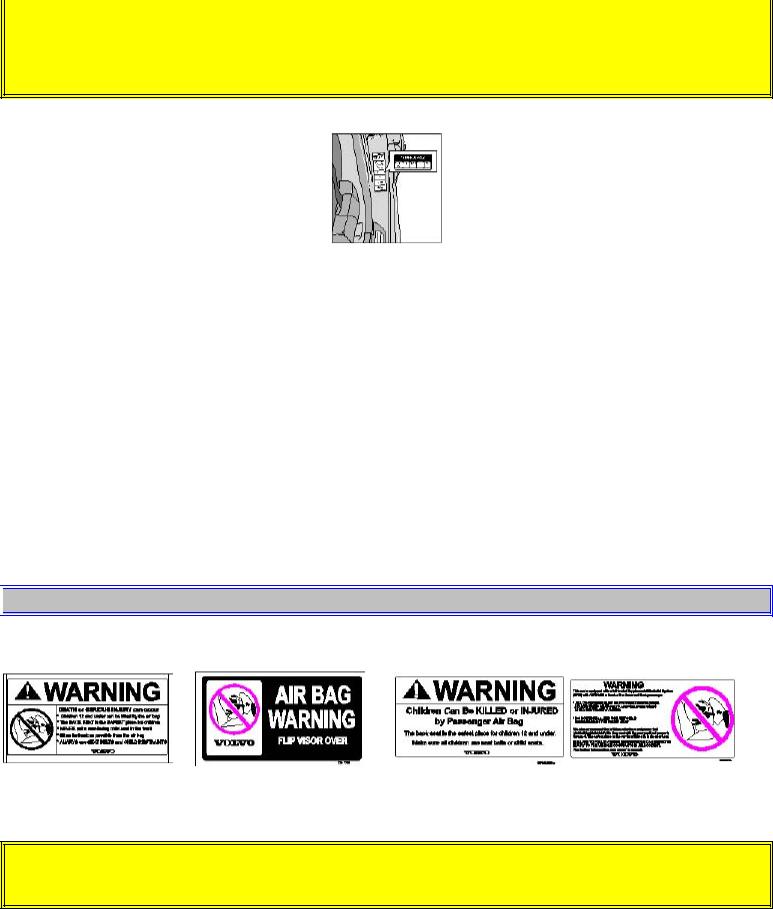
No objects, accessory equipment or stickers may be placed on, attached to or installed near the SRS cover in the center of the steering wheel, the SRS cover above the glove compartment or the area affected by airbag deployment.
If the SRS warning light stays on after the engine has started or if it comes on while you are driving, drive the car to the nearest authorized Volvo retailer for inspection as soon as possible.
SRS decal on door pillar driver's side
There is no maintenance to perform on the SRS yourself. The month and year shown on the decal on the door pillar indicate when you should contact your Volvo retailer for specific servicing or replacement of airbags and seatbelt tensioners. This service must be performed by an authorized Volvo retailer.
Should you have any questions about the SRS system, please contact
your authorized Volvo retailer or Volvo Customer Support:
In the USA: |
In Canada: |
Volvo Cars of North America |
Volvo Cars of Canada Ltd. |
Customer Relations |
175 Gordon Baker Road |
P.O. Box 914 |
Willowdale, Ontario M2H 2N7 |
Rockleigh, New Jersey 07647-0914 1-800-663-8255 800-458-1552

 pg. 6 Volvo SRS
pg. 6 Volvo SRS
SRS texts on inside of both sun visors
SRS texts on outside of both |
SRS texts on the |
SRS text at far right of |
sun visors |
passenger's dash |
instrument panel |
WARNING!
Do not use child safety seats or child booster cushions/backrests in the front passenger's seat. We also recommend that children who have outgrown these devices sit in the rear seat with the seat belt properly fastened.
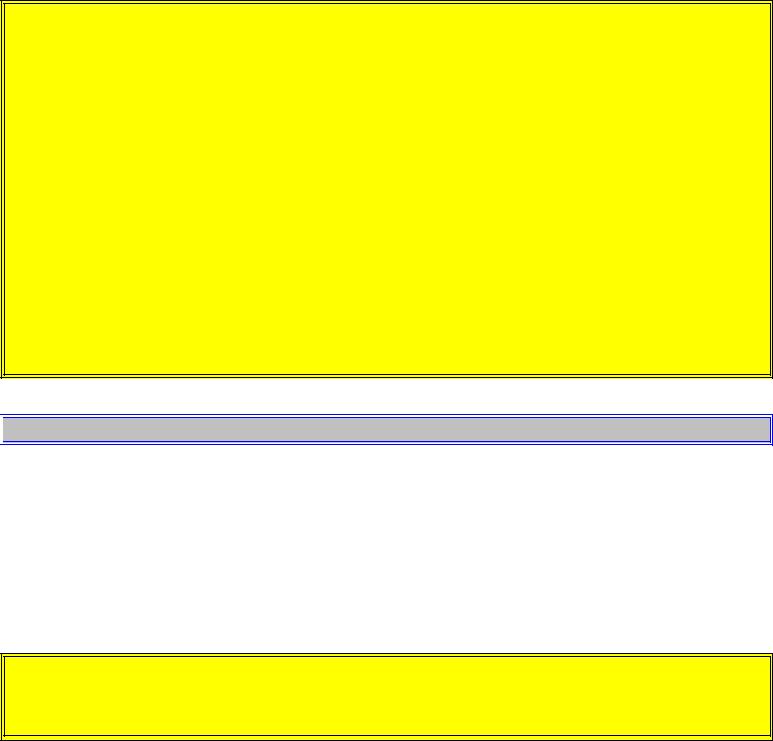
NOTE: Deployment of SRS components occurs only one time during an accident. In a collision where deployment occurs, the air bags and seat belt tensioners activate. Some noise occurs and a small amount of powder is released. The release of the powder may appear as smoke-like matter. This is a normal characteristic and does not indicate fire.
NOTE: NOTE: Volvo's dual-threshold air bags use special sensors that are integrated with the front seat buckles. The point at which the air bag deploys is determined by whether or not the seat belt is being used, as well as, the severity of the collision. Collisions can occur where only one of the airbags deploys.
WARNING!
·Children must never be allowed in the front passenger seat. Volvo recommends that ALL occupants (adults and children) shorter than 4 feet 7 inches (140 cm) be seated in the back seat of any vehicle with a front passenger side airbag.
·Occupants in the front passenger's seat must never sit on the edge of the seat, sit leaning toward the instrument panel or otherwise sit out of position. The occupant's back must be as upright as comfort allows and be against the seat back with the seat belt properly fastened.
·Feet must be on the floor, e.g. not on the dash, seat or out of the window.
·No objects or accessory equipment, e.g. dash covers, may be placed on, attached to or installed near the SRS hatch (the area above the glove compartment) or the area affected by airbag deployment (see illustration).
·There should be no loose articles, e.g. coffee cups, on the floor, seat or dash area.
·Never try to open the SRS cover on the steering wheel or the passenger side SRS seam. This should only be done by an authorized Volvo service technician.
·Failure to follow these instructions can result in injury to the vehicle occupants in an accident.

 pg. 7 Volvo SRS
pg. 7 Volvo SRS
NOTE: The information on this page does not pertain to the Side Impact Protection System airbags.
When are the airbags deployed?
The SRS system is designed to deploy during certain frontal or frontangular collisions, impacts, or decelerations, depending on the crash severity, angle, speed and object impacted. The SRS sensor is designed to react to both the impact of the collision and the inertial forces generated by it and to determine if the intensity of the collision is sufficient for the airbags to be deployed.
WARNING!
The SRS is designed to help prevent serious injury. Deployment occurs very quickly and with considerable force. During normal deployment and depending on variables such as seating position, one may experience abrasions, bruises, swellings, or other injuries as a result of airbag(s) deployment.
If the airbags have been deployed, we recommend the following:
· Have the car towed to an authorized Volvo retailer. Never drive with the airbags deployed.
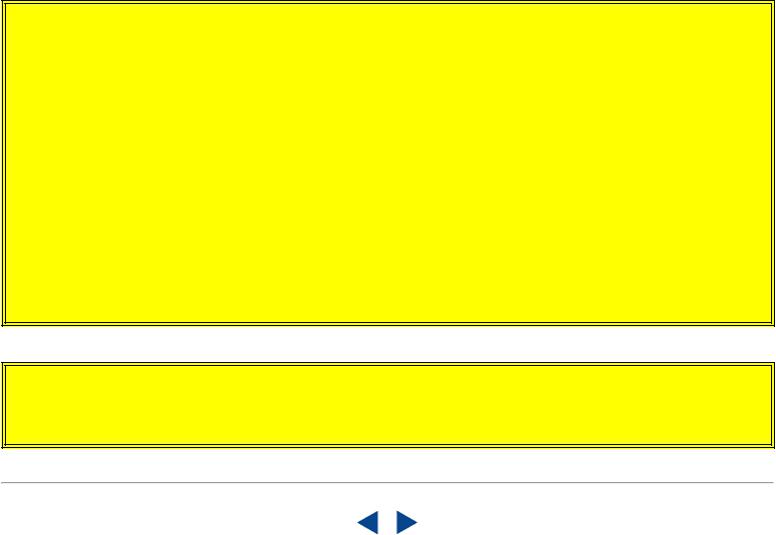
·Have an authorized Volvo retailer replace the SRS system components.
·Use only new, Genuine Volvo Parts when replacing SRS components (airbags, seat belts, tensioners, etc.).
When are the airbags NOT deployed?
Not all frontal collisions activate the SRS system. If the collision involves a nonrigid object (e.g., a snow drift or bush), or a rigid, fixed object at a low speed, the SRS system will not necessarily deploy. Front airbags do not normally deploy in a side impact collision, in a collision from the rear or in a rollover situation. The amount of damage to the bodywork does not reliably indicate if the airbags should have deployed or not.
Seat belts the heart of the Volvo safety system
The heart of the Volvo safety system is the threepoint seat belt (a Volvo invention)! In order for the SRS system to provide the protection intended, seat belts must be worn at all times by everyone in the car. The SRS system is a supplement to the seat belts.
WARNING!
If your car has been subjected to flood conditions (e.g. soaked carpeting/standing water on the floor of the vehicle) or if your car has become flood damaged in any way, do not attempt to start the vehicle or put the key in the ignition before disconnecting the battery (see below). This may cause airbag deployment which could result in personal injury. Have the car towed to an authorized Volvo retailer for repairs.
Before attempting to tow the car, use the following procedure to override the shiftlock system to move the gear selector to the neutral position.
·Disconnect the battery
·Wait at least one minute
·Insert the key in the ignition and turn it to position 1
·Press firmly on the shiftlock override button (located near the base of the gear selector).
·While holding the override button down, move the gear selector from the park position.
WARNING!
Never drive with the airbags deployed. The fact that they hang out can impair the steering of your car. Other safety systems can also be damaged. The smoke and dust formed when the airbags are deployed can cause skin and eye irritation in the event of prolonged exposure.
Contents | Top of Page

2 0 0 1 |
|
|
|
|
VOLVO |
|
|
|
S40 & V 40 |
|
|
|
|
|
|
|
Chapter 2 - Instruments, switches and controls |
|
|
|
|
|
|
|
|
|
|
|
pg. 17 Instruments, switches and controls |
|
|
|
|
|
|
Instruments, switches and controls |
|
|
|
Instruments, switches, controls etc. are described on the following pages. |
|
|
|
|
Instruments |
18 |
|
|
Indicator and warning lights |
21 |
|
|
Headlights, Parking lights, Instrument illumination, Fog lights |
24 |
|
|
Turn signals, home Safe lighting, Wipers/washers |
25 |
|
|
Ignition switch/steering wheel locks, Flashers, Heated rear window/mirrors |
26 |
|
|
Trip Computer |
27 |
|
|
Dynamic Stability Assistance |
30 |
|
|
Cruise control |
31 |
|
|
Heated seats, Parking brake |
32 |
|
|
Ashtrays, Auxiliary socket, Cupholder |
33 |
|
|
Cupholders, Steering wheel adjustment |
34 |
|
|
Heating, Ventilation and Air Conditioning |
35 |
|
|
Electrcaly operated windows |
38 |
|

 pg. 18 Instruments, switches and controls
pg. 18 Instruments, switches and controls
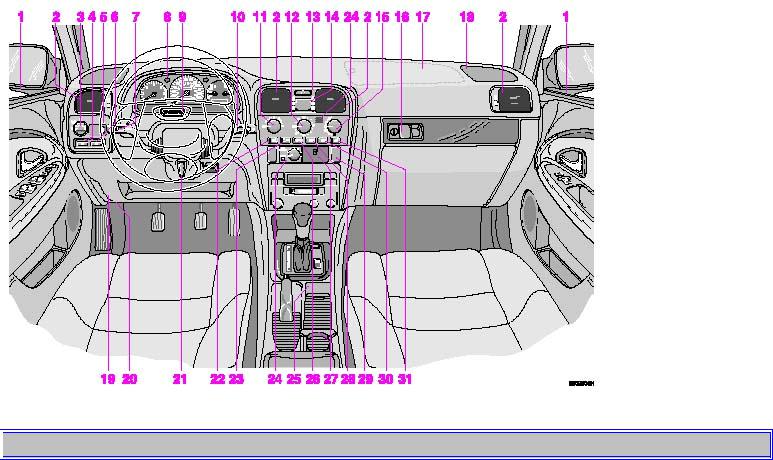

 pg. 19 Instruments, switches and controls
pg. 19 Instruments, switches and controls
Chapter 2 - Instruments, switches and controls
The pages in this section provide detailed descriptions of the vehicle's instruments and controls. Note that vehicles may be equipped differently, depending on special legal requirements.
|
|
Page |
1 |
Adjustable door mirrors |
49 |
2 |
Air vents |
35 |
3 |
Headlight switch |
24 |
4 |
Front foglight switch |
24 |
5 |
Instrument lighting |
24 |
6 |
Rear foglight switch |
24 |
7 |
Turn signals, high/low beams, Home Safe Lighting, cruise control |
31 |
8 |
Instruments, indicator and warning lights |
20 |
9 |
Horn |
|
10 |
Windshield wash/wipe, headlight wash/wipe |
25 |
11 |
Blower control |
36 |
12 |
Air distribution control |
36 |
13 |
Hazard warning flashers |
26 |
14 |
Air flow, air vents |
35 |
15 |
Temperature control |
36 |
16 |
Glove compartment |
45 |
17 |
Passenger airbag |
4 |
18 |
Sunlight sensor for electronic climate control and LED for immobilizer and alarm 37,44 |
|
19 |
Fuse box |
94/95 |

20 |
Hood latch |
52 |
21 |
Steering wheel height adjustment |
34 |
22 |
Heating driver's seat |
32 |
23 |
AC on and off |
36 |
24 |
Trip Computer |
27 |
25 |
Cup holder |
34 |
26 |
Recirculation |
36/37 |
27 |
Cup holder |
33 |
28 |
Defroster |
26 |
29 not in use |
- |
|
30 DSA |
30 |
|
31 |
Seat heater front passenger's seat |
32 |
32 |
Switch for selecting door mirror left and right |
49 |
33 |
Switch for setting door mirrors |
38 |
34 |
Door mirror switch |
38 |
35 |
Window left and right front |
38 |
36 |
Window left and right rear |
38 |
37 |
Cut-out switch windows rear |
38 |
Controls in center console
Some of the items listed on this page are available on certain models only.

 pg. 20 Instruments
pg. 20 Instruments
1 Clock reset knob
Turn the knob:
Clockwise: advance
Counterclockwise: set clock back The longer the knob is turned, the faster the setting will change.

2Clock
3Tachometer
Reads thousands of engine rpm. The needle should never be in the solid red range.
4 Trip odometer reset button
Press the button to reset the trip odometer. The ignition must be switched on.
5Odometer
6Speedometer
7Trip odometer
Used for measuring shorter distances. The last digit indicates 1/10 mile/kilometer.
8 Fuel gauge
Fuel tank capacity: 16 US gallons (60 liters).
When the warning light comes on there is approximately 1.5 US gal. (7 liters) of fuel remaining. See "Refueling" for additional information. When refueling the fuel gauge needle will not register until the volume of gasoline in the tank exceeds 3.5 US gal. (12 liters).
9 Trip Computer/Ambient temperature
NOTE: See page 2729 for information on the trip computer.
10 Temperature gauge (engine coolant)
Do not drive the car with the pointer in the red range. The pointer should be approximately midway on the gauge face when driving. If the pointer approaches the red range repeatedly, check coolant level. See page 117.

 pg. 21 Indicator and warning lights
pg. 21 Indicator and warning lights
1 Turn signal, left
2 Turn signal, right
3 Fuel level low
4 Front fog lights on
5 Rear fog lights on
6 Rear fog lamp on
7 Cruise control
8 High beams on
9 ABS (anti-lock brakes) malfunction
10 Door open
11 Parking brake applied
12 Low oil pressure

13 Hazard warning light on
14 Fault in SRS system
15 Brake circuit not working (brake fluid level too low) and EBD 16 Battery charge failure
17 DSA (option)
18 Automatic transmission: position W, 4 or 3 or L 19 Check engine light
20 Immobilizer on
21 Service Reminder Indicator
22 Low washer fluid level
23 Turn indicator trailer (certain models)
Starting check
After a few seconds, all lights except 9 and 20 will go out. Once the engine starts, 9 and 20 will also go out.
* Indicates failure of a brake light, not failure of the braking system (see item 15).

 pg. 22 Warning lights
pg. 22 Warning lights
The warning lights described on pages 22 and 23 should never stay on when driving
When the ignition key is turned on and before the engine starts, all of the warning lights should go on to test the function of the bulbs. Should a light not go off after the engine has started, the system indicated should be inspected. However, the parking brake reminder light will not go off until the parking brake has been fully released.
 Supplemental Restraint System (SRS)
Supplemental Restraint System (SRS)
If the light comes on (or stays on after the vehicle has started), the SRS diagnostic system has detected a fault. Drive to an authorized Volvo retailer for an inspection of the system. See the SRS section for more information.
Check Engine Lamp
If the lamp comes on (or stays on after the vehicle has started), the engine diagnostic system has detected a possible fault in the emission control system. Although driveability may not be affected, see an authorized Volvo retailer as soon as possible for inspection.
Canadian models are equipped with this warning light: 
NOTE: If the fuel filler cap is not closed tightly or if the engine is running when the car is refueled, the Check Engine Lamp may indicate a fault. However, your vehicle's performance will not be affected. Use only Volvo original or approved fuel filler caps.
 Oil pressure warning light
Oil pressure warning light
If the light comes on while driving, stop the car and then stop the engine immediately and check the engine oil level. See page 114. If the light stays on after restart, have the car towed to the nearest authorized Volvo retailer. After hard driving, the light may come on occasionally when the engine is idling. This is normal, provided it goes off when the engine speed is increased.
 Parking brake reminder light
Parking brake reminder light
This light will be on when the parking brake (hand brake) is applied. The parking brake lever is situated between the front seats.

Canadian models are equipped with this warning light: 
WARNING!
If the fluid level is below the lowest MIN mark in the brake fluid reservoir: DO NOT DRIVE. Tow the car to a Volvo retailer and have the brake system checked and any leakage repaired.
 Brake failure warning light
Brake failure warning light
If the light comes on while driving or braking, stop immediately, open the hood and check the brake fluid level in the reservoir. See page 116 for reservoir position.
If the control lamp still stays on, the EBD (Electronic Brakeforce Distribution) is not working.
Drive to your Volvo dealer. See ABS control lamp and also page 71.
Canadian models are equipped with this warning light: 
 Bulb failure warning light
Bulb failure warning light
The light will come on if one of the brake light bulbs are defective when the brake pedal is pressed.
Check the fuse and bulb. See sections "Replacing bulbs" and "fuses".

 pg. 23 Warning lights, Daytime Running Lights
pg. 23 Warning lights, Daytime Running Lights
 DSA (option)
DSA (option)
Dynamic Stability Assistance
This is a system which helps keep the drivewheels from spinning. The light flashes if the road surface is slippery, the wheels are spinning and the system is working.
The control light comes on if a fault occurs in the DSA system. It also comes on if the system is switched off via the switch.
For more information see page 30.
 Service reminder indicator
Service reminder indicator
This light will come on according to preset service intervals or after 750 hours of driving or after 12 months, whichever occurs first. It is a reminder to the driver that the service interval has been exceeded. The light will stay on for 2 minutes after start until reset by the servicing retailer.
 Anti-lock Brake system (ABS)
Anti-lock Brake system (ABS)
If the warning lamp lights up there is a malfunction of the ABS system (the standard braking system will however function). The vehicle should be driven to a Volvo retailer for inspection.
See page 71 for additional information.

Daytime Running Lights:
The S40 and V40 come from the factory with daytime running lights activated. Carry out the following steps if you will deactivate them. These steps may be carried out again to reactivate and deactivate the daytime running lights as desired.
Programming for On or OFF
Turn the headlight switch to position  .
.
Turn the ignition key in position II.
Pull the turn signal lever towards you and hold it while turning the headlight switch to position 0.
WARNING!
Do not activate or deactivate the daytime running lights while driving. Laws in your area may mandate the use of daytime running lights. Check your local laws before deactivating daytime running lights.

 pg. 24 Headlights, Parking lights, Instrument illumination, Fog lights
pg. 24 Headlights, Parking lights, Instrument illumination, Fog lights
A Headlights and parking lights
0Switch position
Ignition key in positions 0+I: All lights switched off
Ignition key in position II:
Low beam headlights on (+ front and rear parking lights, license plate light and instrument lighting).
 Switch position
Switch position
Parking lights front and rear.
Ignition key in positions 0, I and II
Parking lights should only be used when the car is parked, never when the car is being driven.
It also switches on the position lights in bumpers, and license plate light (and the instrument lights in position II).
 Switch position
Switch position
Ignition key in positions 0 and I: All lights off.
Ignition key in position II: Headlights on (+ parking lights front and rear, license plate light, position lights in the bumpers and instrument lights).
Note: You have to turn the light switch to this position in order to switch on high beams.
B Instrument lighting dimmer
Instrument lighting can be dimmed to 6% of maximum lighting.
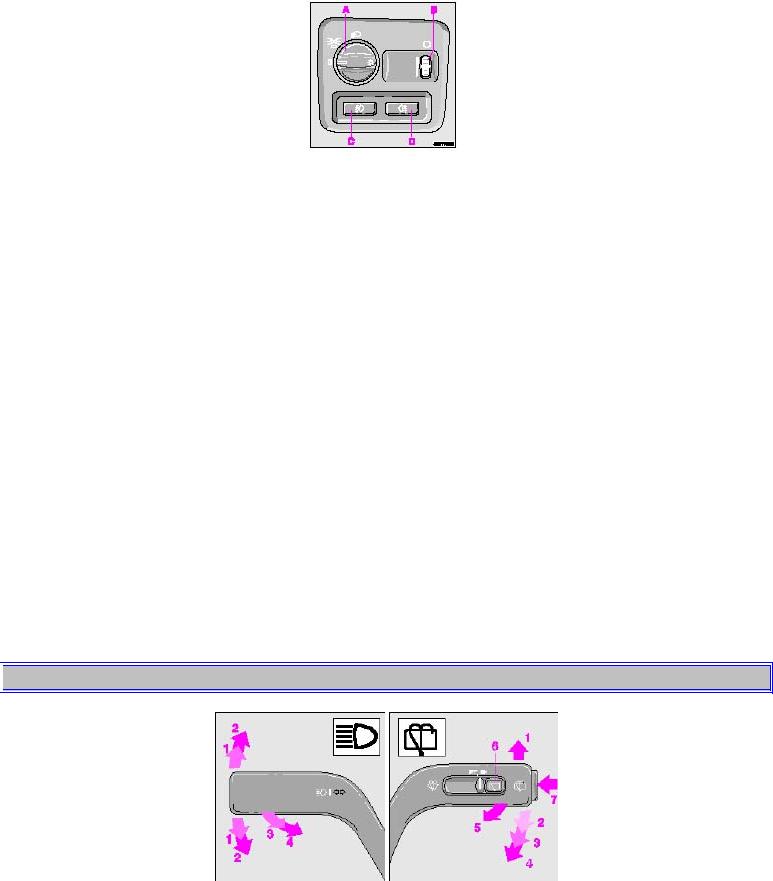
Rear fog light *
The rear fog light (located in the driver's side tail light cluster) is considerably brighter than the normal tail lights and should be used only when the atmospheric conditions, such as fog, rain, snow, smoke or dust reduce the daytime or nighttime visibility of other vehicles to less than 500 ft (150 meters).
C D Fog lights
Ignition key must always be in position II.
Headlight or parking lights must be activated
-Front fog lights (option): press 
-Rear fog light: press  - headlights or front fog lights must be activated Switching fog lights off
- headlights or front fog lights must be activated Switching fog lights off
To switch the fog lights off, press the appropriate fog light switch again.
If headlights or parking lights are switched off, the fog lights will also go out. The fog lights are also switched off when the ignition is switched off and must be switched back on manually if required when the ignition is switched on again.
The fog lights switch off automatically when the high beams are switched on.
* By design, there is one rear fog light only, located in the driver's side tail light cluster.

 pg. 25 Turn signals, Home Safe lighting, Wipers/washers
pg. 25 Turn signals, Home Safe lighting, Wipers/washers
Turn signals |
Wipers/washers |
Turn signals
1 Lane change position. In maneuvers such as lane changing, the driver can flash the turn signals by moving the turn signal lever to the first stop and holding it there. The lever will return to the neutral position when released.
2 Signal lever engaged for normal turns.
3 High beam/low beam switch (headlights on).
Move the lever towards the steering wheel and release it.
4 Headlight flasher (headlights off).
Move the lever towards the steering wheel. The headlight high beam will be on until the lever is released.
NOTE: A defective turn signal bulb will cause the turn signal indicator and remaining signal lights to flash more rapidly than normal.
Home Safe lighting
When you leave your car at night, you can make use of the exterior courtesy lighting function:
·Remove the key from the ignition switch.
·Pull the turn signal lever towards the steering wheel (as when using the headlight flasher function). The low beam headlights will now remain on for 30 seconds to light your way.
Repeat the above measures if you want to switch off the Home Safe Lighting.
Wipers/washers
1 "Single sweep" position:
The switch returns automatically when released. 2 Intermittent wiper
The wipers will sweep approximately every 5 seconds (car speed depending). 3 Wipers, normal speed
4 Wipers, high speed
5 Windshield wiper/washer, headlight wiper/washer.
The wipers will make 23 sweeps across the windshield and headlights and 1 additional sweep after 3 seconds. 6 Tailgate window wiper (V40)
The tailgate wiper switch has two positions:
OFF
ON : intermittent and synchronized with windshield wiper
Tip function

When pressing switch 7 briefly the wiper will make one sweep, independent of the interval
Backing up
When the vehicle is put into reverse with the windshield wipers on and tailgate wiper off, the rear window wiper will come on for two sweeps.
7 Tailgate window washer (V40)
The washer keeps working for as long as you keep the button depressed.
The wiper will make 2-3 sweeps after the lever is released and 1 sweep after 3 seconds.
Contents | Top of Page
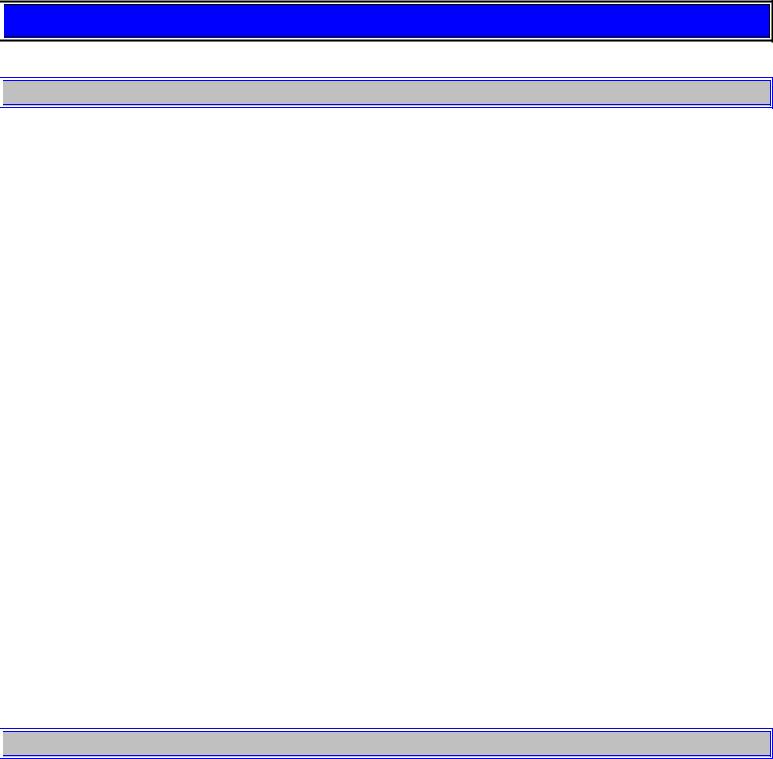
2 0 0 1 VOLVO S40 & V40

 Chapter 3 - Body and interior
Chapter 3 - Body and interior

 pg. 39 Body and interior
pg. 39 Body and interior
Body and interior
The seats, sun roof, mirrors, etc. are described on the following pages.
Keys |
40 |
Doors and locks |
41 |
Remote keyless entry system |
42 |
Alarm |
43 |
Trunk/Tailgate/Glove compartment |
45 |
Child safety locks |
46 |
Front seats |
47 |
Rear/side view mirrors/Vanity mirrors |
49 |
Interior lights, Sun roof |
50 |
Sun roof |
51 |
Hood/Luggage cover |
52 |
Storage compartments |
53 |
Cargo space/Trunk light, Spare tire, Jack |
54 |
Folding rear seat |
55 |
Folding rear seat, Luggage strap |
56 |
Side cargo net, Cargo net |
57 |
Weight distribution, Handling, Roadholding, Roof rack |
58 |

 pg. 40 Keys
pg. 40 Keys
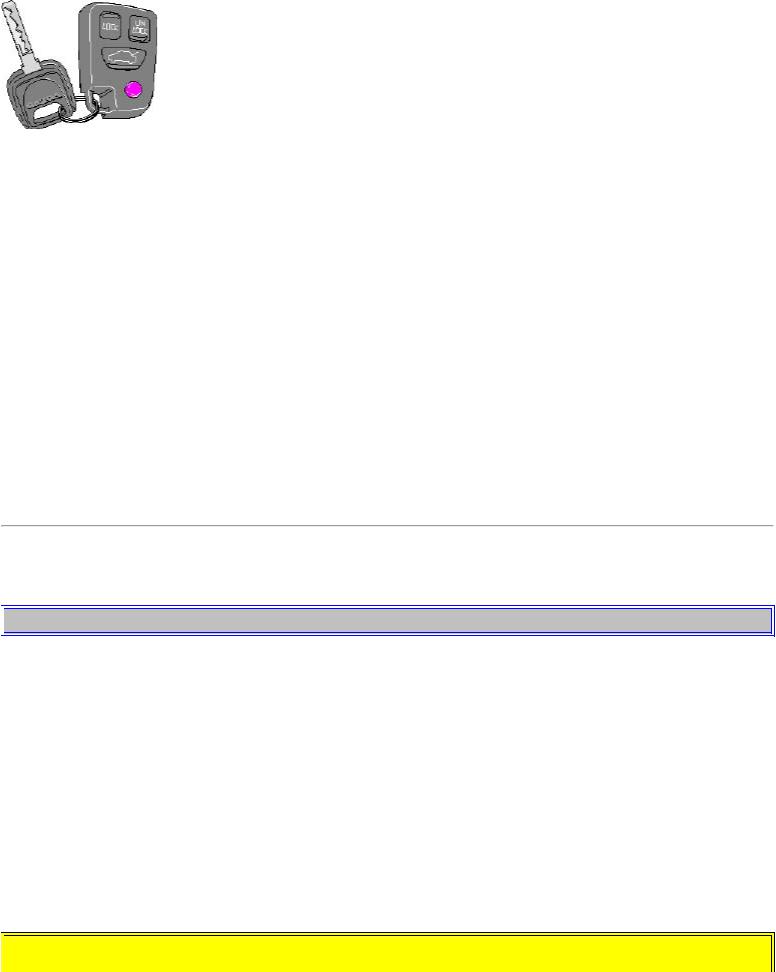
Key
The key activates all locks (ignition switch/steering wheel lock, all doors including the fuel filler door, trunk/tailgate, and the glove compartment).
Immobilizer (start inhibitor)
Each of the keys supplied with your car is electronically coded. When the key is inserted into the ignition switch, the code is transmitted to and compared with a code stored in the start inhibitor module. The car can only be started if a properly coded key is used.
If you misplace a key, take the other keys to an authorized Volvo retailer. The existing code in the start inhibitor module and all the keys will be erased as an antitheft measure and a new code will be programmed in.
NOTE:
You should never keep more than one of your ignition keys on the ring at the same time. This could cause conflicting signals to be transmitted to the ignition switch, making it impossible to start the car.
This device complies with part 15 of the FCC rules. Operation is subject to the following condition: (1) This device may not cause harmful interference, and (2) this device must accept any interference received, including interference that may cause undesired operation.

 pg. 41 Doors and locks
pg. 41 Doors and locks
Doors and locks
Your car is equipped with a central locking system.
The key, used on the driver's door, the remote control, or central locking button, will lock/unlock all doors, trunk/tailgate.
Turn the key once to unlock the driver's door and the fuel filler door.
Turn the key again within 10 seconds to unlock other doors, trunk/tailgate.
One turn with the key towards "lock" in the driver's door locks all doors, trunk/tailgate and fuel filler door with a 10 minutes delay in the fuel filler door.

 WARNING!
WARNING!
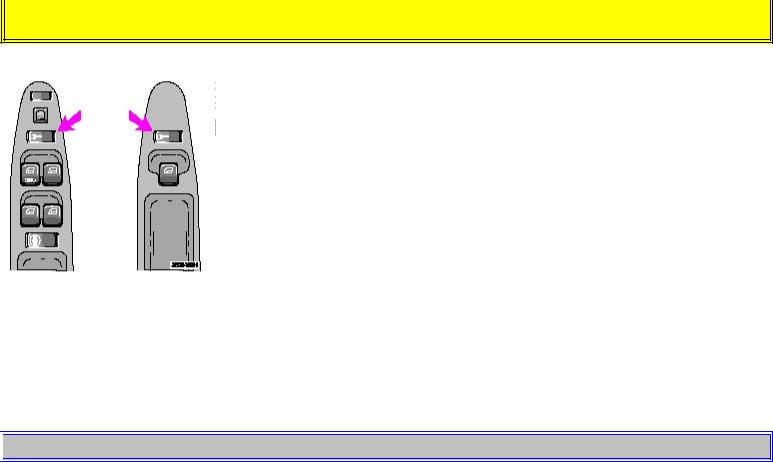
If the doors are locked while driving, this may hinder rapid access to the occupants of the car in the event of an accident. (Also see information on "Child safety locks").
Central locking button
Central locking switch
You can use the button to lock or unlock all doors (unlock only for 25 seconds after locking by remote). LEFT side of button: lock RIGHT side of button: unlock
Note: If the key is in the ignition switch and you close the driver's door, the driver's door will be immediately unlocked again in order to prevent accidentally locking the car with the keys left inside the car.

 pg. 42 Remote keyless entry system
pg. 42 Remote keyless entry system
Remote keyless entry system
Your car is equipped with a remote control transmitter. This transmitter uses a radio frequency which will allow "keyless" entry into the passenger compartment or the trunk. You will be supplied with two coded key ring transmitters, which will enable you to lock/unlock all doors and the trunk/tailgate and fuel filler door from a distance of 10-15 feet (3-5 meters).
The Remote also activates/deactivates the alarm system that comes standard with this car.
The car can also be locked/unlocked with the key.
Using the remote control
·Press the LOCK button once to lock all doors and trunk/tailgate.
·Press the UNLOCK button once to unlock the driver's door and the fuel filler door only. Press this button again (within 10 seconds) to unlock other doors, trunk/tailgate.
·Press the OPEN trunk/tailgate button to unlock the tailgate/trunk.
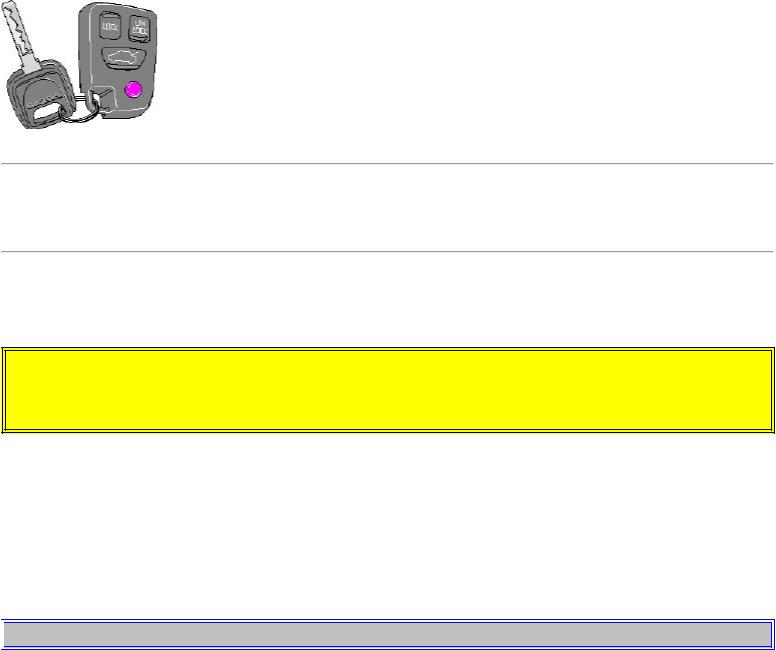
This device complies with FCC rules Part 15. Operation is subject to the following two conditions: (1) This device may not cause harmful interference and (2) this device must accept any interference that may be received, including interference that may cause undesired operation.
NOTE: If only the driver's door is unlocked, the lock will automatically reengage (re-lock) and the alarm will be set after 2 minutes unless the door has been opened (see page 44).
The lock/unlock and alarm features can also be utilized by using the keys. See section: Doors and Locks on page 41.
WARNING!
Volvo does not recommend using the transmitter to lock the doors from inside the car. The alarm would be activated and would sound when one of the doors is opened. The doors must not be locked using the remote transmitter while the vehicle is occupied. In case of an accident, this may hinder rapid access to the occupants of the vehicle.
Remote control not functioning.
If the remote control is not functioning the car can be started as follows:
Open the driver's door with the key.
Note: The remote control will not function if a key is left in the ignition switch.

 pg. 43 Alarm
pg. 43 Alarm
Alarm
The radio signal emitted from the transmitter, which is used to set/unset the alarm, is a "rolling code" signal. This means that the signal is changed randomly for each transmission and is intended to help prevent unauthorized recording of the code.
When armed (set), the alarm continuously monitors a number of points on the car. The following conditions will set off the alarm:
·The hood is opened
·The trunk/tailgate is opened
·A door is opened
·The ignition switch is tampered with
The alarm will sound for 30 second intervals, with a 10 second pause between intervals. This function cannot be interrupted.
· If the battery or the siren are disconnected, the alarm will sound for five minutes

Arming (setting) the alarm
Press the LOCK button on the remote control, lock the car using the key in the driver's door . One long flash of the turn signals will confirm that the alarm is set.
Disarming the alarm
Press the UNLOCK button on the remote control or unlock the driver's door with the key.
Turning off (stopping) the alarm
If the alarm is sounding, it can be stopped by pressing the UNLOCK button on the remote control or by unlocking the driver's door with the key.
Visual alarm signal
If the alarm is set off, a visual alarm signal is given by flashing all turn signals and turning on the interior lighting for approximately 5 minutes.
Audible alarm signal
If the alarm is set off, an audible alarm signal is given by the backup siren. One alarm cycle lasts for 30 seconds.
"Panic" function
In an emergency situation, this feature can be used to attract attention, if you are within 10-15 feet (3-5) meters of the car. .
Activate the "panic" function by pressing the red panic button on the remote control for at least 3 seconds or by pressing this button twice within 3 seconds. The turn signals will flash, the interior lights will go on and the alarm will sound.
The "panic" alarm can be turned off after 5 seconds by pressing any of the buttons on the remote control or it will stop automatically after 25 seconds.
NOTE: This button will NOT unlock the car.

 pg. 44 Alarm
pg. 44 Alarm
LED alarm status signals
The status of the alarm system is indicated by the red LED at the right side of the dash:
·LED off - the alarm is not armed (set)
·LED flashes once per second - the alarm is armed (set)
